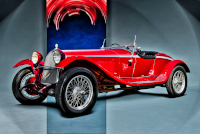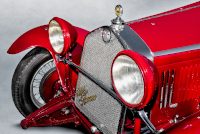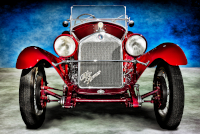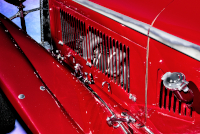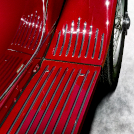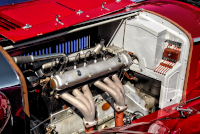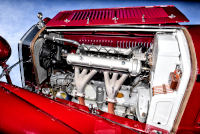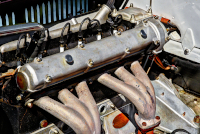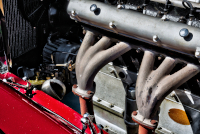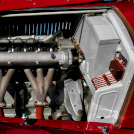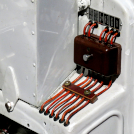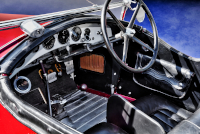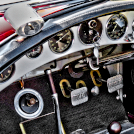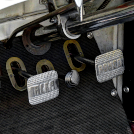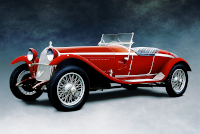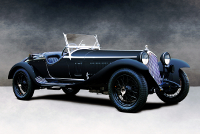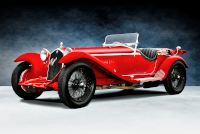Location:
St. Michaels Concours d'Elegance, 2016
St. Michaels Concours d'Elegance, 2008
Owner: John H. Willock | Chestertown, Maryland
Prologue:
A decent 6C 1750 profile is foundational. The 6C marks the point at which Alfa Romeo establish the sports car formula and set the course for the great Italian sports cars of the classic era. The stock of 6C 1750 cars photographed at auction and depicted in text is extensive, but chassis #8513045, with its bare wheels and tall stance, stands out among the lot.
We first spotted this car in 2008. Eight years later, we found the opportunity to make some decent images. In my unfinished shots, the owner-of-record sits nearby. He was a nice man—enjoying the Eastern Shore afternoon, smiling and chatting with folks while sitting alongside his old companion. Of the Alfa Romeo, the car appears in lovely driving condition. The motor in particular shows beautiful patina, worth a close look.
Chassis #8513045 had long been the first entry in the Alfa Romeo portfolio, and for many years relied on one old image. As the project evolved, I grew frustrated that the first profile in the master list was neither artistically polished nor representative of a decent survey. Our later encounter in 2016 presented an opportunity to give the 6C story some much-needed spectacle. From that sunny afternoon there remain strange light facets and weird shadows, and for that I like the work; it is sparkly and saturated and quite specific to the time and place.
- - - - - - - - - -
► Image Source 1-6, 8-13, 15-16, 19: Nikon D750 (24.3 MP) | Image Source 20: Nikon D200 (10.2 MP)
Image Source 7, 14-15, 17-18 by E, illustrated by the author: Canon CMOS (20.3 MP)
References:
- Automobile Quarterly, Volume 7, Number 2, "Alfa Romeo 6C 1750" by Michael Lorrimer, The Kutztown Publishing Company, Inc., Kutztown, PA, page 200
- Boyne, Walter J. "Power Behind the Wheel, Creativity and the Evolution of the Automobile" Stewart, Tabori & Chang, Inc., New York, NY. 1988, page 162-164
- Christie's International Motor Cars - Pebble Beach Auction Catalogue, 1999, Alfa Romeo 6C 1750 Gran Sport, 1931 page 122-123
- Czap, Nick. "Museo Storico Alfa Romeo: The catalogue" Giorgio Nada Editore, Milano, Italia. 2015, page 55
- Zagato: The factory maintains an online database of their work.
- Bonhams: Chassis #8513033 sold at auction in 2008.
- Bonhams: Chassis #10814356, sold at auction in 2014.
- UltimateCarPage: General information, photographs, and dedications to specific chassis, by Wouter Melissen, January 16, 2014.
The greater family of the 6C Alfa Romeo became the archetype for volume production sports cars. Although each one benefits from the considerable engineering prowess of Vittorio Jano, Alfa Romeo produced many thousands of 6C spiders, demonstrating that a fast, reliable platform could be improved over numerous iterations to yield world-beating results. This strategy drives the formula for Porsche in the post-War era. In any case, the 6C cars take from Alfa's antique era sporting roots a sense of mounting excitement in the automobile as a competitive instrument, and imbue the simple steel chassis with more athleticism than most any driver had previously enjoyed. From 1500 cc to 1750 cc, the early 6-cylinder cars of Jano's devising build the foundation for an Italian love story filled with euphoric victory and tragic death, as well as the arrival of one Enzo Ferrari, then a young driver and Alfa Romeo team manager.
For the Gran Sport, forced induction raises power from around 64 brake horsepower up to 85 bhp, but more practically provides a wealth of mid-range grunt that the period's naturally aspirated cars do not possess. In the classic era, Italy constructed a broad network of autostrada, and Alfa Romeo cars set out to make full use of it. Whereas the typical flow of traffic would amble along anywhere between 40 and 50 miles per hour, the 6C 1750 Grand Sport can easily double that. Later 8-cylinder Alfa Romeo cars will do better than triple that figure, but being more exotic represent a sophisticated hammer pounding the already delicate boundaries of speed on public roads. The 6C is nothing quite so drastic, but still bears the seed of those incredible sports cars.
Motor: 1,752 cc straight 6-cylinder, cast iron block, iron hemi-head | 65 mmx 88 mm | 5.0:1 compression
Valvetrain: DOHC, 2 valves per cylinder
Aspiration: Memini DOA dual-choke carburetor, Roots-type supercharger
Power: 85 bhp @ 4,500 rpm
Drivetrain: 4-speed gearbox, rear-wheel drive
Front Suspension: beam axle, semi-elliptic leaf springs, friction dampers
Rear Suspension: live axle, semi-elliptic leaf springs, friction dampers
Architecture: pressed steel ladder-frame chassis with aluminum body by Zagato of Terrazzano di Rho, Lombardia
Kerb Weight: 920 kg (2,028 lbs)
Wheelbase: 2,745 mm (108.1 inches)
0-60: about 14.0 seconds
Top Speed: 145 km/h (90 mph)
Etymology:
'6C 1750' refers to the motor configuration, a straight 6-cylinder of about 1.75 litre displacement. 'Gran Sport' refers to the fourth series update of Alfa Romeo's well tested Super Sport platform, with the notable addition of a roots supercharger. The term 'spider' descends from the carriage trade, which in motorcar parlance came to refer to open sports cars. 'Zagato' is the Milanese coachbuilder who provided the aluminum coachwork.
Figures:
From 1929 to 1933, Alfa Romeo built a reported 2,579 examples of the 6C 1750, doing so in six different configurations over four successive development series. In truth, the 6C is a model split across the 6C 1500 (Series 1 and 2), and the 6C 1750 (Series 3 through 6). These figures make the 6C 1750 a volume production sports car at a time when the thing itself does not exist. Of the total production figure, Alfa Romeo built 257 Gran Sport Spiders, all from 1930 to 1933. Of these, 213 comprise the 4th and 5th series from 1930 to 1932, whereas the 44 6th series cars are slightly more refined. Zagato most often provided the coachwork.
Common Qualities: Minor Differences among 6C 1750 Cars
Most examples of the 6C 1750 are not vastly dissimilar from one another, but all seem to be slightly different in some detail. The retrospective eye could expect as much from a series of Alfa Romeo sports cars with custom coachwork, and yet the volume we are considering numbers in the thousands. What makes sense then is to consider that the classic era is a prosperous time for the coachbuilding trade. Automobiles find a use for skilled craftsmen, and as auto racing pushes those skills to the limit, repeatable techniques from aviation filter down to four-wheel transport.
It might be worth comparing this fourth series car with the black fifth series car from 1931, chassis #10814368. The fourth series car here turns out athletically simple, carrying a few nicks along the way. Wheel and tire selection, grille, headlamp pods, windscreen, louvres, and most notably the running gear all mark differences in refinement, rather than technology.
Each 6C Alfa tends to its own personality. Chassis #8513045 seems to sit high in comparison with other examples. The bare metal wheels call attention to the car's posture, and mark the attitude as still somewhat antique, rather than purely classic. Similarly, the Dunlop Gold Seal tyres use a taller sidewall than the Michelins often seen on similar cars. Tall tyres and thin running gear enunciate the flatness of the design, whereas others, like our Series V car, look softer, smoother, and sportier.
Fourth Series: Design Notes on the 4th Series Alfa Romeo 6C 1750 Zagato
The chrome along the shoulder stretches uninterrupted from the grille to the tail. The doors stand straight, while some cars feature cut-down doors. The fenders sweep down then curve up without much hint of skirting or sensuality. This spider does without a hood, keeping the back deck simple. The windscreen can be folded to reduce drag. The louvres in the bonnet vent the motor. The louvres just behind on the bulkhead vent the cockpit footwell; here the louvres are small and trapezoidal in shape, whereas in other versions the louvres sit within a larger, rectangular cut-out.
A chrome brace runs along the lower edge of the body, then sweeps up along the edges of the door; later cars will do without chrome on the front edge of the door cavity. Chassis #8513045 also wears a prominent stone guard over the grille. Eight chrome strakes on the leading edge of the rear fender marry the vertical repetition of the louvres with nascent streamlining trends, strictly ornamental. All told, the 6C 1750 Gran Sport depicted here looks a standard example of the breed, with all its subtle peculiarities.
Inside-Out: Details of the 6C 1750 Motor
Images 7 and 12 reveal the low, frontward position of the carburetor and supercharger, whereas the head looks like plain camshafts sitting on bare block. You may also wish to compare these spartan camshaft covers with those of the luxurious 8C 2900B. Note the casting shape at the rear of the motor, accommodating the drive gears, and how that shape forms the center of the shafts in the eight-cylinder car. Though not entirely identical, this feature demonstrates Jano's concept of combining two high-revving four-cylinder motors to create a high-revving, dual overhead-cam straight-eight. I also love the ghost grey color of the bulkhead and firewall, reminiscent of the aircraft kits . The rivets and bolts and pressed panel lines give the machine an aviation-inspired finish.
The oval plaque on the block describes the type of oil to use in winter (inverno) and in summer (estate). Heading the plaque is the trademark "S.A.I. Ing. N. Romeo & C. - Milano," referencing Nicola Romeo's engineering company, which precedes by a few years the consolidation of the companies that formed Alfa Romeo. The prominent fuse box labels read, left to right: the front left headlight (luce piena faro sinistro), the front right headlight (luce piena faro destro), auxiliary headlights (lamp ausil fare, which do not appear fitted to the car), the fuel pump (pompa benzina), coil ignition (bobina), and the tail light (stop). If I've mis-represented any of these translations, please let me know.
Pedal Arrangement: Alfa Romeo Central Throttle Layout
The most important feature of the cockpit is the central throttle location, the round pedal that sits between the clutch pedal (labeled 'ALFA') and the brake (labeled 'ROMEO'). Stitched-in mesh helps to screen air from the vents in the footwell, and the floor still appears rudimentary—flat and rather carriage-like.
Last Updated: Mar 26, 2025

